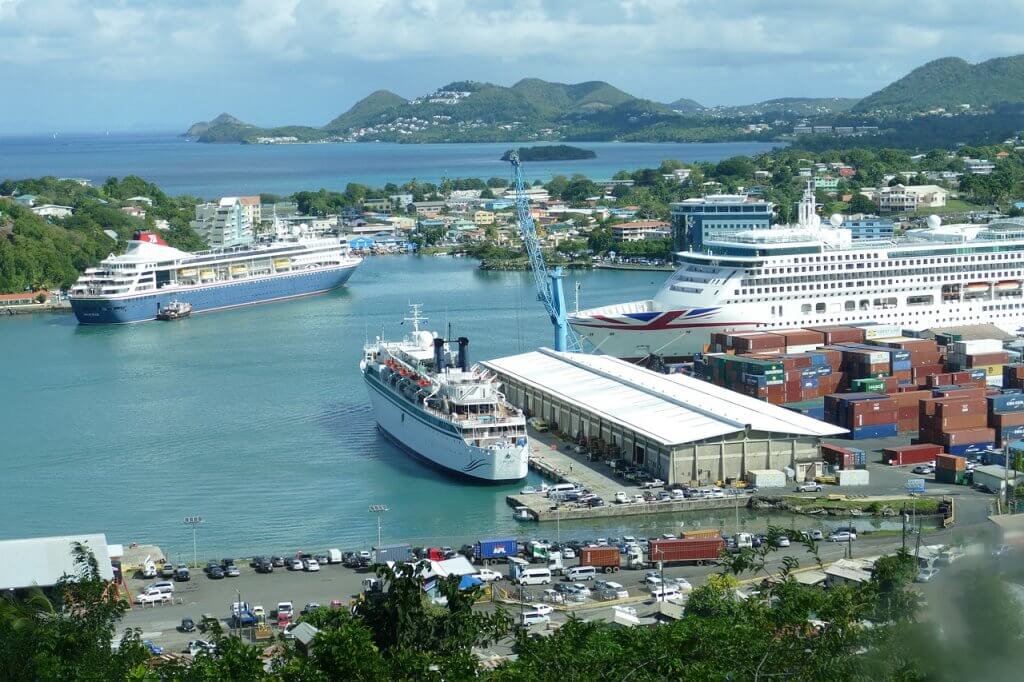Planning a trip to St. Lucia? You’ll want to get your entry requirements sorted before you book that flight.
The good news is that St. Lucia keeps things refreshingly straightforward for most visitors. No visa hassles, no complicated forms, no bureaucratic nightmares.
But here’s the thing: “straightforward” doesn’t mean you can just show up. There are specific documents you need, forms to complete, and rules to follow. Miss one, and you might find yourself stuck at the airport.

This travel guide to St. Lucia walks you through everything you need to enter St. Lucia in 2025, from passport validity to electronic forms to what cruise passengers need to know.
Contents
- 1 Who Needs a Visa for St. Lucia?
- 2 Passport Requirements That Actually Matter
- 3 The Electronic Immigration Form Nobody Tells You About
- 4 What Immigration Officers Will Ask For
- 5 Special Rules for Traveling With Children
- 6 What Cruise Passengers Need to Know
- 7 Health Requirements You Can’t Ignore
- 8 Safety Considerations for 2025
- 9 When to Visit St. Lucia
- 10 Getting Around St. Lucia
- 11 Accommodation Options Across All Budgets
- 12 Beyond Tourism: Residency and Citizenship Options
- 13 What You Should Actually Do
- 14 Final Thoughts
Who Needs a Visa for St. Lucia?
Most travelers can breathe easy here. If you’re from the US, UK, Canada, or any EU country, you don’t need a visa for tourist stays.
You can stay for up to 6 weeks without any visa paperwork. Some nationalities get even longer—up to 90 days in certain cases.
But not everyone gets this free pass. Citizens from countries outside these regions may need to apply for a visa before arrival. The St. Lucia government recommends doing this well in advance, not at the last minute.
Here’s what matters more than visa status: your passport.
Passport Requirements That Actually Matter

Your passport needs to be valid for at least 3 to 6 months beyond your departure date from St. Lucia. Different sources cite different timeframes, but the 6-month rule is your safest bet.
Why the confusion? Because immigration officers have discretion. One might let you through with 3 months’ validity; another might not. Better to have that 6-month buffer and avoid the risk entirely.
You also need at least one blank page in your passport. Not for stamps necessarily, but because that’s the official requirement. No blank pages? Get a new passport before you travel.
The Electronic Immigration Form Nobody Tells You About
Here’s where most travelers hit their first snag. St. Lucia requires all arriving passengers to complete an electronic immigration form within three days before arrival.
This isn’t optional. It’s mandatory. And “within three days” means exactly that—complete it too early, and you might need to do it again.
The form is available through an online portal set up by the St. Lucia government. You’ll need basic travel information: flight details, accommodation address, contact information.
Complete it on your phone while waiting at the departure gate if you must. Just don’t skip it entirely.
What Immigration Officers Will Ask For
Beyond your passport and completed electronic form, immigration officers expect to see proof of accommodation and an onward or return ticket.
The accommodation part is straightforward. A hotel booking confirmation works. So does a rental property agreement or an invitation letter from a resident if you’re staying with someone.
The return ticket requirement trips up some travelers. You need to show you’re leaving St. Lucia at some point. An open-ended one-way ticket? That’s going to raise questions.
Immigration officers can also ask about your financial means. They want assurance you can support yourself during your stay. Credit cards, bank statements, or cash on hand all work as proof.
Will they ask everyone? No. But they can ask anyone. Being prepared means having these documents readily accessible, not buried in checked luggage.
Special Rules for Traveling With Children
Traveling with minors adds another layer of requirements. If a child is traveling with only one parent or unaccompanied, you’ll need notarized parental consent and proof of parentage.
This applies even if the parents are divorced and one parent has full custody. St. Lucia’s immigration authorities don’t automatically know your family situation. Bring the documentation.
Birth certificates serve as proof of parentage. For the consent letter, both parents should sign it in the presence of a notary public. Include contact information for the non-traveling parent.
Traveling as a family unit? You’re fine. But better to know these rules exist than to discover them at immigration.
What Cruise Passengers Need to Know

Cruise travel to St. Lucia operates under slightly different rules. If you’re on a closed-loop cruise—meaning you depart from and return to the same US port—you have more flexibility with travel documents.
You can use a passport card, participate in Trusted Traveler programs, or carry an enhanced driver’s license instead of a full passport book.
But here’s the catch: most experienced travelers recommend bringing a regular passport anyway. If you have a medical emergency and need to fly home, those alternative documents won’t help you board an international flight.
Children under 16 can enter by sea with just a birth certificate when accompanied by a legal guardian. Again, this only applies to sea travel, not air arrivals.
Health Requirements You Can’t Ignore
St. Lucia doesn’t require extensive health documentation for most travelers. But yellow fever vaccination is mandatory if you’re arriving from an endemic area.
The list of endemic countries includes much of sub-Saharan Africa and tropical South America. Coming from Brazil? You need that yellow fever certificate. Flying in from London? You don’t.
Standard traveler health precautions still apply. Travel insurance is always smart, even when not required. Medical facilities in St. Lucia are adequate but limited compared to larger countries.
Safety Considerations for 2025
The US State Department maintains a Level 1 travel advisory for St. Lucia—”Exercise Normal Precautions.” That’s the lowest risk level possible, the same as most Western European countries.
This doesn’t mean crime doesn’t exist. Petty theft happens, especially in tourist areas. But violent crime against tourists remains rare.
The bigger safety concern is usually environmental. The rainy season from May to November brings increased precipitation and occasional tropical storms. Check weather forecasts before you travel.
When to Visit St. Lucia
December through April represents peak season. The weather is ideal for beaches, hiking the Pitons, and exploring the island’s cultural offerings. But you’ll pay premium prices and compete with larger crowds.
May through November sees fewer visitors and lower prices across accommodations and tours. The tradeoff? More rainfall and higher humidity. Not constant downpours, but frequent afternoon showers.
Shoulder season—late April or early May, and November—often offers the best balance. Decent weather, smaller crowds, and reasonable prices.
Getting Around St. Lucia
St. Lucia has two international airports. Hewanorra International Airport (UVF) serves most international flights and sits on the southern end. George F.L. Charles Airport (SLU) handles regional connections and is closer to the northwest resort areas.
Taxis are readily available but unmetered. Agree on fares before starting your journey. Rental cars give you more flexibility, though driving is on the left side of the road.
Minibuses offer the cheapest transport option and run along main routes. They’re not on fixed schedules—they leave when full. Budget extra time if you’re trying to catch a flight.
Accommodation Options Across All Budgets
St. Lucia’s accommodation landscape runs from budget guesthouses to ultra-luxury resorts. Sugar Beach and Jade Mountain are the marquee properties, commanding premium rates for good reason.
Boutique hotels and eco-lodges cluster around Soufrière, near the Pitons. These offer personality and proximity to natural attractions without luxury resort prices.
Booking during the low season can save 30-50% on accommodation costs. Many properties offer special packages during these months to fill rooms.
Beyond Tourism: Residency and Citizenship Options
Some visitors fall so deeply in love with St. Lucia that they want more than tourist access. The island nation offers a citizenship by investment program that grants full citizenship and a passport in exchange for qualifying investments.
This isn’t for casual tourists. The program requires substantial financial commitment—either a contribution to the National Economic Fund, investment in approved real estate, or investment in government bonds.
But for those seeking a second passport with visa-free access to over 140 countries, it’s worth exploring with a licensed agent for the program, such as Global Residence Index, which has helped numerous clients navigate the St. Lucia citizenship application process.
What You Should Actually Do
Here’s your action checklist for entering St. Lucia:
- Verify your passport has at least 6 months validity and one blank page
- Complete the electronic immigration form within three days of arrival
- Book your accommodation and keep the confirmation accessible
- Purchase a return or onward ticket before departing
- Gather consent letters and documentation if traveling with minors
- Check yellow fever requirements if coming from endemic areas
- Consider travel insurance for medical emergencies
Most travelers breeze through St. Lucia immigration in under 30 minutes. Having your documentation organized and readily available makes the process even smoother.
Final Thoughts
St. Lucia’s entry requirements aren’t complex, but they do exist. The electronic immigration form catches some travelers off guard. Passport validity rules confuse others.
Take 20 minutes to get your documents in order before you leave home. That small investment of time prevents major headaches at immigration.
And once you’re through? St. Lucia delivers on its reputation. UNESCO World Heritage Pitons, drive-in volcano experiences, rainforest adventures, and Caribbean beaches that actually live up to the photos.
The entry requirements are just the gateway. What’s waiting on the other side makes the paperwork worthwhile.
This post was written by Hannah Mejorada - an industry expert in citizenship by investment and golden visas.
